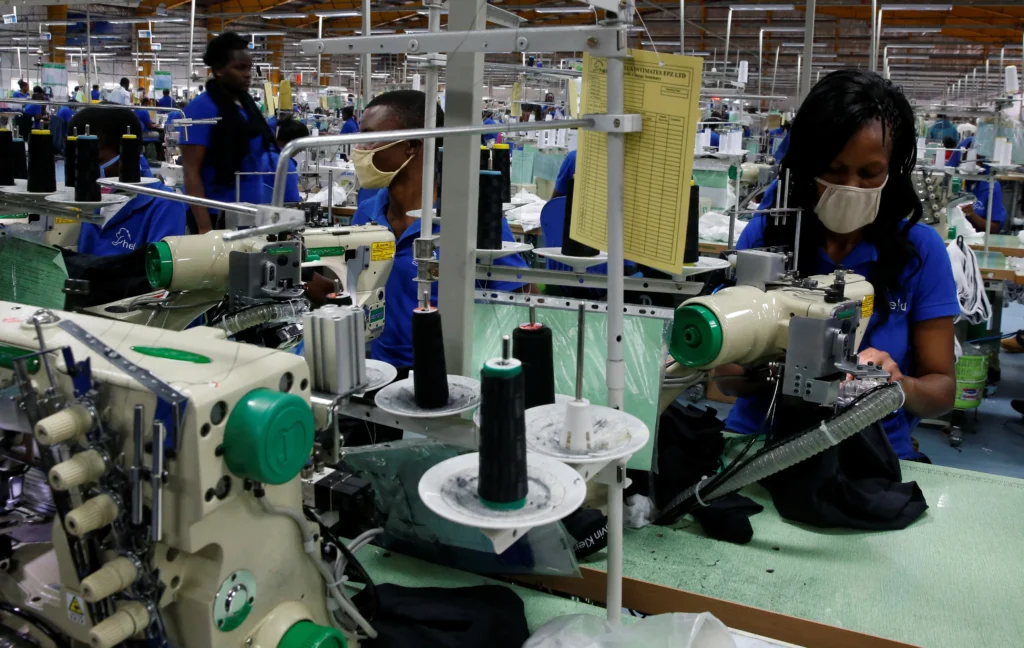- High protection and heavy import dependency have left industries in Africa poorly prepared for international competition.
- The tendency of many African governments to assign a leading role to the state in creating and operating manufacturing firms makes industries in Africa hard to thrive.
- For decades, investments by African governments are often made with little regard to efficiency and the managerial capacity in target industries.
Africa Industrialization Day on November 20 is here, yet the region’s skies remain smokeless. While the region is endowed with $82 trillion worth of discovered natural resources, with the potential to contribute $30 billion a year in government revenue over the next 20 years, this potential remains untapped.
Africa’s failed industrialization
Sadly, Africa’s industrialization has been failing if not stagnating as many nations continue turning into customers of established manufacturing zones in China, Europe and India. For instance, Africa exports around 69 per cent of the world’s raw cocoa beans but imports tonnes of the finished products which fetch better prices.
“There is no country in the world that achieved economic growth without the manufacturing sector,” said Kitila Mkumbo, Tanzania’s Minister of State in the President’s Office (Planning and Investment), during his keynote address at the Tanzania Energy Congress in September 2023.
This sentiment is not only evident in other established regions such as the Middle East and Asia but also within Southern Africa. South Africa, in particular, has demonstrated the vitality of a diverse industrial complex.
Similarly, AfDB argues that transforming the region’s agriculture sector stands to open markets worth more than $100 billion a year by 2025. These numbers mean that agribusiness is a wealth creation machine for Africa, untapped and unexplored fully.
According to a collaborative study by a US-based think tank, Brookings, AfDB, and United Nations University-World Institute for Development Economics Research (UNU-WIDER), some of the region’s competitive economies have set up public policies to promote industrial development.
Read also: Industries without smokes: A new path to employment in Africa
Early adopters of industries in Africa initiative
Ethiopia, Ghana, Kenya, Tanzania, Mozambique, Nigeria, Senegal, and Uganda were among Africa’s early industrializers and the region’s beacons of growth turnaround. Recently, Tanzania (Agenda 10/30), Kenya (Vision 2030), and Uganda (East African Crude Pipeline Project, EACOP) have divested their attention and resources towards attaining an industrial competitive taste, across the agribusiness and energy sectors.
However, there is a much deeper underlying factor behind the drastic failure of Africa’s industrialization. Brookings argues that trade shocks and economic crises of the 1970s and 1990s brought along a 20-year period of macroeconomic stabilization, trade liberalization, and privatization.
“Import competition forces inefficient firms, both public and private, out of business. Uncertainty with the outcome of the adjustment process and low or negative economic growth meant that there was little private investment overall and practically none in the industry. Political instability and conflict also caused investors to hold back. When Africa emerged from its long economic hibernation around the turn of the 21st century, African industry was no longer competing with the high-wage industrial “North,” as it had in the 1960s and 1970s. It was competing with Asia. From the point of view of industrial development, the timing of the region’s economic recovery was unlucky, to say the least,” Brookings study reads in part.
Further, bad policies contributed to the downfall Africa’s industrialization, particularly across sub-Saharan nations. They all assumed similar policies for industrial development: state-led import substitution, structural adjustment, and investment climate reform.
Read also: Banning Second-Hand Clothes Key to Jump Starting Africa’s Textile Industries
Imports slowed pace of industries in Africa
“Import substitution sowed the seeds of its destruction. High protection and heavy import dependency meant that African industry was poorly prepared for international competition. The tendency of many African governments to assign a leading role to the state in creating and operating manufacturing firms simply made the problem worse. Investments were often made with little regard to efficiency, and the managerial capacity of the state was badly overstretched,” the study commented.
AfDB pointed out that infrastructure deficit limits the region’s growth in the manufacturing sector. Africa faces a steep infrastructure deficit, estimated at 30 per cent to 60 per cent of productivity losses of firms, with 40 per cent to 80 per cent of this due to the energy sector in half the nations.
Energy issues are not foreign to the region. Energy consumption per capita in Africa (except South Africa) is less than 200 Kilowatts compared to 13,000 Kilowatts in the United States of America and 7,000 Kilowatts in Europe.
“Poor energy quality imposes additional costs on companies such as idle workers, spoiled materials, lost production, damaged equipment, and restart costs. Between 2010 and 2016, there were on average 8.5 power outages a month, with an average duration of 4.1 hours. The cost of power outages is estimated at 5.4 per cent of annual sales. To deal with these cuts, 51.3 per cent of firms use their own generators for about 13.4 per cent of their electricity consumption, increasing their costs,” AfDB notes in part.
An unfavorable business environment has been an issue for quite some time. Although things are changing for countries such as Kenya, Tanzania, and Rwanda with their pro-investment policies, the region still has a long way to go.
Technological advancements
The time to start a business came down from 63 days in 2005 to 27 days in 2016, and the cost of business start-up procedures, from 198 per cent of per capita gross national income to 54 per cent, according to AfDB.
Pre-colonial existing industries such as textiles, fishing, mining, and agriculture are not the bedrock of sustaining the region’s economy but the longevity of sustainable living for Africa. Africa’s commercial fishing dates back to the 1500s, and today the sector contributes 8.1 per cent to world fishery production, a marginal growth from 5.9 per cent in 1950.
This is a result of the expansion of exclusive economic zones to 200 miles, technological advancements in the marine sector, and rising interest from developing countries to harness the fishing capacity of African waters.
However, the above example can be replicated across other sectors in the region. The African Union finds a couple of ideas essential towards propelling the Africa’s industrialization forward. Intra-African value chain integration is key to reducing export dependency on unprocessed goods and natural resources and paving the way towards higher value addition and a more diversified export basket.
“61 per cent of intra-African trade occurs in processed and semi-processed goods, and exports to Africa are more diversified and technologically advanced than those to other regions. Increasing the competitiveness of African value chains will also increase resilience to supply chain shocks, made more evident by the COVID-19 pandemic,” AU report commented in part.
Read also: Uganda woos UAE investors to drive key export industries
Can Made in Africa initiative power industrialization
The continent can’t avoid the vitality of promoting the African Fashion Value Chain particularly for developing economies. Despite job creation and lowering poverty rates, there is a silver lining, when right things are aligned such as effective policies, enabling business environments, capacity building, access to finance, market access, and enforcing standards, quality, and certification.
“For Africa to trade with itself, it is important to map out the comparative advantages, the quality and safety of the products, their social and environmental footprints and movement of the goods and services, aligned to promoting the full potential gains of the AfCFTA. The goal is to move towards a continent that trades in goods and services which are wholly made in Africa or are substantially transformed within the continent with attendant conferring of such goods or services as Made in Africa,” the AU report said.
Overall, Africa needs to set up its politics in the right tune that supports industrialization and entrepreneurial adventures for its people.











